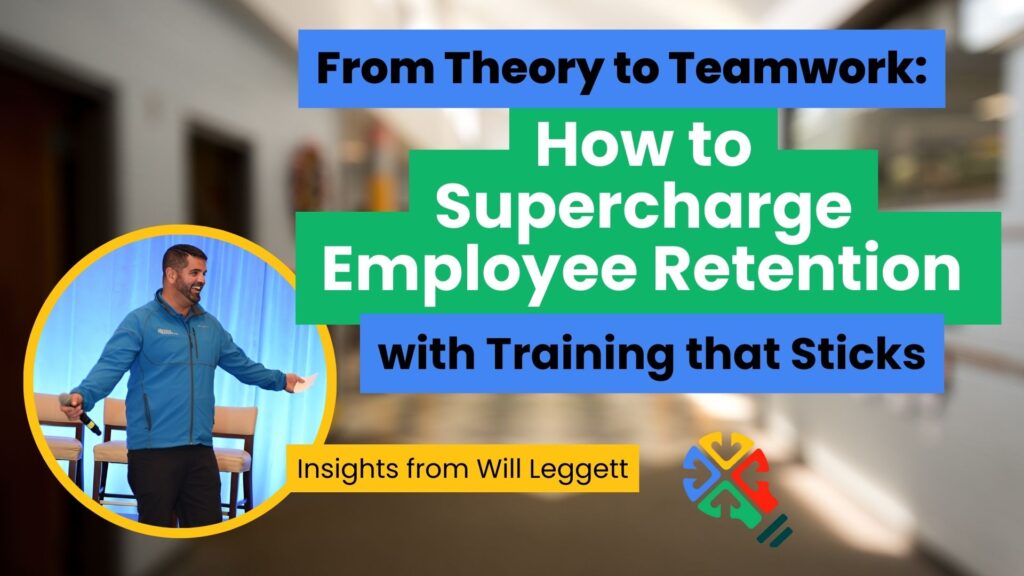
From Theory to Teamwork: How to Supercharge Employee Retention with Training that Sticks
From Theory to Teamwork: How to Supercharge Employee Retention with Training that Sticks https://teamue.com/wp-content/uploads/2024/09/corporate-training-1024x576.jpg 1024 576 admin https://secure.gravatar.com/avatar/c315242f7f2cb219daf4e1fb6baa57e1?s=96&d=mm&r=gWith today’s job market hotter than a summer sidewalk, keeping employees around is tougher than ever. Training programs can help, but without team-building, they often fall flat.
So, how do you create a corporate training program that actually sticks and keeps your team motivated?
Will Leggett, United EVENTures’ president, has the answer: Combine skill development with team-building fun.
Let’s see what he has to say below.
Planning Successful Corporate Training and Development
The Problem: Corporate Training Without Team Building Falls Flat
Most companies invest in training and development to boost skills, increase ROI, and keep employees engaged. Sounds great, right?
The problem is that many of these programs focus solely on delivering information, leaving employees disconnected from each other and the company’s mission.
Sure, they might leave the session with more knowledge, but without team unity, it’s like trying to run a marathon with only one shoe on—it’s possible but not ideal.
As Will explains, “Training and development is huge because every company wants the same thing: better ROI and higher retention.”
But here’s the twist—focusing only on training isn’t enough. Without addressing team dynamics and communication, employees might absorb information, but they won’t have the tools to apply it effectively.
Disconnected Teams Lead to Disengagement and High Turnover
Let’s face it—people aren’t robots (even if they sometimes move like one after a long meeting). Without connection, employees check out faster than a Netflix binge.
Disconnected teams struggle to implement new strategies even with the best training.
Why? Because they aren’t on the same page. They might return to their departments with great ideas, but without a unified vision, communication falls apart, goals get misaligned, and performance takes a nosedive.
This is where team-building comes in.
By addressing personality differences and decision-making styles through tools like the DiSC Assessment or the Myers-Briggs Type Indicator, teams can break down barriers that usually slow them down.
Will sums it up nicely: “When leadership teams go back to their departments and say, ‘Hey, this is how we’re going to implement it this year,’ they need that team-building piece to actually make it work.”
It’s not just “nice-to-have” fluff. Team-building is essential to ensuring training actually makes an impact.
Team Building Supercharges Training (And It’s More Fun Than a Spreadsheet)
Imagine this: You’ve just sat through a jam-packed training session, and your brain is swimming with new information. Instead of returning to the office, you get to participate in a scavenger hunt with your colleagues.
Sounds more like summer camp than work, right?
But that’s precisely what makes team-building so powerful.
“Team-building exercises allow teams to have some fun and walk away with clear steps on what they need to do to be productive moving forward,” says Will.
When teams understand each other’s communication styles, strengths, and weaknesses, they can apply what they learned in training with far greater success. The key is making sure the training isn’t just an information dump but also an opportunity for connection.
United EVENTures blends tools like DiSC Assessments and Tuckman’s Model of Team Development (you know—the whole forming, storming, norming, performing thing) to help teams understand their dynamics and work together better.
By integrating these tools into the training process, teams don’t just learn—they bond, and that’s when the real magic happens. As the team develops maturity and ability, relationships get established, and leadership styles change from top-down to more collaborative or shared.
Actionable Team Building Builds Real Results
Training isn’t just about individual skills anymore. When paired with team-building activities, training becomes an opportunity to create authentic connections, align on company goals, and implement strategies that last longer than a week. Tools like Myers-Briggs and Tuckman’s Model aren’t just optional add-ons—they’re the foundation for high-functioning teams.
Next time you plan a training session, don’t overlook the power of team building. It’s not just about having fun (though that’s definitely a bonus). It’s about driving meaningful change that leads to higher retention, better performance, and, let’s be honest, fewer awkward coffee breaks where no one knows what to say.
As Will says, “You’re not just training employees—you’re creating stronger teams that work together to achieve company goals.”
Ready to take your team from ‘just trained’ to ‘truly thriving’?
Discover how United EVENTures can transform your next training session into an unforgettable, retention-boosting experience.


